VI. The Thracian inscriptions
The Thracian inscriptions discovered up to now, were written as unseparated words in Greek letters, which creates many difficulties in their interpretation. Four inscriptions are long enough and are of some significance:
1. An inscription on a golden ring from the village of Ezero,
P![]() rvomaj district, dating to the V-th
c. BC.
rvomaj district, dating to the V-th
c. BC.
2. An inscription on a stone plate from the village of Kjolmen, Preslav district, probably dating to the VI-th c. BC.
3. An inscription on a golden ring from the village of Duvanli, Plovdiv district, probably dating to the V-th c. BC.
4. An inscription, repeated four times on four silver vessels discovered in a mound near the same village of Duvanli, dating to the end of the V-th or the beginning of the IV-th c. BC.
1. The Ezero inscription
The inscription was found in the 1912 excavation of a mould near the
village of Ezero, P![]() rvomaj district.
It consists of eight lines and 61 letters engraved on a golden ring:
rvomaj district.
It consists of eight lines and 61 letters engraved on a golden ring:
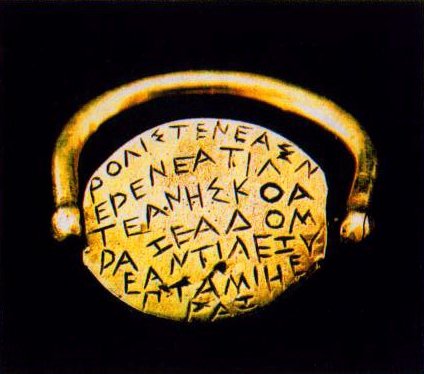
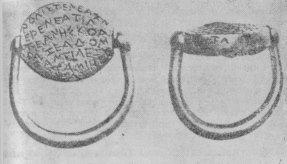
The text is:
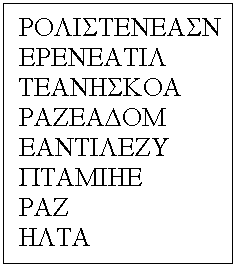
In the same neighbouhood besides the ring there were found other items belonging to a burial – a golden diadem, a small golden spoon, two triangular golden plates, a broken bronze vessel, a round bronze mirror and a broken bronze bracelet. It was obvious that the golden ring belonged to the burial of a noble Thracian. The reading of the letters poses no difficulties but division of the text into words is uncertain. Up to now there appeared more than 20 translations of this text [See D. Detschew, Die thrakischen Sprachreste, Wien, 1957, pp.567-582], none of them being commonly accepted. Here we list the interpretations of the Buglarians academicians D. Dechev and Vl. Georgiev.
D. Dechev proposed the following reading:
Text:
Rolisteneas Nerenea tiltean esko Arazea domean Tilezupta mie erazilta
Translation: “I am Rolesteneas, a descendant of
Nereneas. Tilezipta, an Arazian woman,
delivered me to the ground (i.e. buried me).”
Vl. Georgiev also thought that the ring was specially made for a solemn (three-days long) exposure of the deceased before he was buried. He also utilized the Herodotus’ account that some Thracian tribes had the custom when some noble Thracian dies, to bury with him one of his favourite wives. He proposed the following reading:
Text:
Rolistene, as Nerenea Tiltea nesko arazea do mean tilezyptam, ie eraz
elta
Translation: “Rolistene (=You, Rolisten), I, Nerenea
Tiltea, die peaceful next to [you] my dear deceased,
[I] who nourished (brough up) the children.”
2. The Kjolmen inscription
It was carved on a stone plate (broken in the upper part) which was
found lying above a grave excavated in 1965 at the village od Kjolmen,
Preslav district. It is also written with Greek letters but in a peculiar
way: one line was written from right to the left, the next one – from left
to the right, etc. (it is the so called bustrophedon, used by the
Greeks in the VI c. BC.):

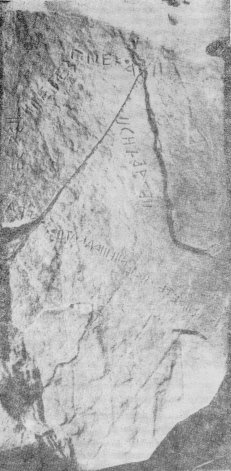
The inscription consists of 56 letters in three lines:

The inscription referred to a burial and this facilitates its interpretation. Vl. Georgiev offered the following reading:
Text:
Ebar Zes(a) asn HN etes igek. A
N blabahe gn!
N ua(s?) sn letedn ued(n), ne in dakatr s!
Translation: “Ebar (son) of Seza(s) I 58 years lived
here.
Do not damage this (grave?)!
Do not desecrate the very this deceased, for this (the same) will be done
to you!”
The Kjolmen inscription comes from south-eastern Moesia, at the northern boundary of Thracia according to Vl. Georgiev, and shows some (Daco)Moesian features. Thus Georgiev regards the language of the inscription as belonging to a transitional Thraco-Moesian dialect.
3. The inscription on the golden ring from Duvanli
This ring was found next to the left hand of a skeleton in the Arabadzhjiska mould at the village of Duvanli, Plovdiv district. The ring has the image of a horseman and an inscription surrounding the image:
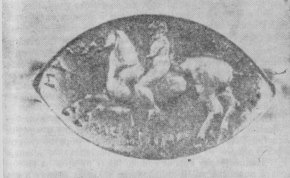
The inscription is only partially preserved – only 16 out of the initial 21 letters are readable:

The interpretation of Vl. Georgiev is the following:
Text:
eys, ie … dele, mezenai.
Translation: “(You) powerful, help … protect, (you)
horseman!”
The image of the horseman clarifies the word mezena as meaning
‘a horseman’. The Thracian mezena (mezenai in the text) is almost identical
to the name (the epithet) of the Messapian deity of (Iuppiter) Menzana,
the “horse deity” to which were sacrificed horses. It also corresponds
to the Albanian mes, mezi (‘a stallion’) and the Romainan
m![]() nz
(‘a stallion’). The latter is Dacian in origin from the IE *mend(i)- ‘a
horse’. The Thracian mezena and the Messapian Menzana – from the IE *mendiana
mean ‘a horseman’.
nz
(‘a stallion’). The latter is Dacian in origin from the IE *mend(i)- ‘a
horse’. The Thracian mezena and the Messapian Menzana – from the IE *mendiana
mean ‘a horseman’.
4. The inscription on the four silver vessels from Duvanli
These vessels together with other artefacts were unearthed from the Bashova mould at the village of Duvanli, Plovdiv district. The inscription consists of eight letters:

Dechev interprets it as a personal name Dadalemes. Such a name, however, is not attested. According to Vl. Georgiev the inscription consists of three words which form a sentence. His interpretation is:
Text:
Da, dale me!
Translation: “(You) Land (Demethra) guard (protect, defend)
me!”
In support of this reading he cites the correspodent translation of
the above phrase into Albanian, which would sound as: Dhem del (zot) m![]() .
The Albanian language, as a successor of the Dacian language, was closely
related to Thracian.
.
The Albanian language, as a successor of the Dacian language, was closely
related to Thracian.
5. The inscriptions from the island of Samothraci
Besides these four inscriptions, there are around twenty inscriptions
on vases of fragments of vases from the island of Samothraci. They are,
however, only partially preserved and very short.
[Previous] [Next]
[Back to Index]